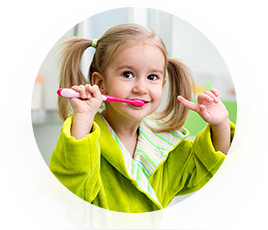If your child hates brushing, make it fun—use music, let them pick their toothbrush, and brush together. Stick to a routine, praise their efforts, and avoid pressure. If issues continue, talk to a pediatric dentist.
"Go brush your teeth!"
If you've ever found yourself yelling those words across the house, you aren't alone. It's notoriously hard to get kids to brush their teeth, and studies show that only about one-third of preschoolers have seen a dentist by the recommended age.
Yet teaching good dental habits early in life is one of the most important gifts you can give your child. Dental health doesn't just affect the mouth—it has long-term effects on their overall well-being. Poor dental hygiene is linked to everything from gum disease to serious conditions like diabetes, heart disease, and even cognitive decline in adulthood.
The good news? Teaching good dental care doesn’t have to be a battle. With a few creative strategies and a consistent routine, you can help your child go from toothbrushing tantrums to oral health success.
Here’s our complete guide to dental care for kids who hate to brush their teeth—designed with real families in mind.
Why is Dental Care So Important?
Before jumping into brushing techniques, let’s understand why dental care matters so much—even for baby teeth that eventually fall out.
Long-Term Health Starts with the Mouth
Oral hygiene plays a critical role in long-term health. Inflammation caused by gum disease can spread beyond the mouth, contributing to serious systemic conditions like:
- Heart disease
- Alzheimer’s disease
- Diabetes
- Pregnancy complications
Although these don’t show up until adulthood, the groundwork for preventing them starts in childhood—with daily brushing, flossing, and healthy habits.
Understanding the Role of Gums
Gums are more than just a frame for your teeth. They're made up of soft tissue packed with tiny blood vessels and act as a barrier against harmful bacteria. When gums are healthy, they provide a tight seal that blocks germs from entering your bloodstream.
But when neglected, inflamed gums form pockets where bacteria multiply. This leads to gingivitis and, if untreated, progresses to periodontitis—an advanced form of gum disease that may result in tooth loss and other health issues.
That’s why even if your child’s baby teeth fall out eventually, taking care of their gums and oral hygiene sets them up for a healthier future.
Why Kids Avoid Brushing Their Teeth
Before diving into strategies, it’s important to understand why children resist brushing in the first place. Common reasons include:
- Sensory issues: Some kids find the feeling of bristles or toothpaste overwhelming.
- Taste and smell aversions: Not all toothpaste flavors are child-friendly.
- Lack of control: Being told what to do can make brushing feel like a power struggle.
- Boredom: Brushing can feel repetitive and dull without entertainment or stimulation.
- Discomfort or pain: If brushing hurts due to cavities or gum sensitivity, children will avoid it.
Understanding the root cause helps tailor your approach to what your child truly needs.
Want to Invest in Your Oral Health Now?
Get a free Dental Insurance quote here.
Get QuotesBasic Dental Care for Kids: The 4-Step Routine
Building a simple, structured dental care routine is the first step to success. These four steps are the foundation of healthy teeth and gums—and they’re easy enough for kids to learn with a little help.
1. Brushing
Two minutes may feel like a long time, especially for squirmy little ones. But proper brushing ensures plaque and food debris are thoroughly removed from teeth and gums.
Make Brushing Fun
Turn brushing into a fun, rewarding activity:
- Timers: Use a 2-minute sand timer or a fun toothbrushing app with music and animations.
- Stickers or charts: Give rewards for brushing streaks (e.g., a week of consistent brushing earns a small prize).
- Let them choose: Let your child pick their own toothbrush and toothpaste. Characters, colours, and flavoured toothpaste can make brushing exciting.
Also, be sure the toothbrush is the right size for their mouth and has soft bristles to avoid hurting sensitive gums. Replace the brush every 3–4 months or when the bristles become frayed.
2. Flossing
Flossing is just as important as brushing—and kids should start learning it as soon as they have two teeth that touch.
Flossing gets into those tiny spaces that a toothbrush can’t reach and helps remove plaque and food particles. It also strengthens gums and reduces inflammation.
Flossing Tips for Kids
- Use floss picks if regular floss is too tricky for small hands.
- Teach them to gently slide the floss between teeth and curve it around the gumline on both sides.
- Make it a habit by flossing after brushing, ideally once a day—preferably at night.
Regular flossing helps prevent bleeding gums and keeps their mouth healthier in the long run.
3. Mouth and Gum Care
Beyond brushing and flossing, overall mouth hygiene should also include cleaning the tongue, cheeks, and using a mouth rinse when appropriate.
Mouth rinses help kill bacteria that remain after brushing and flossing. However, only older children who know how to swish and spit should use mouthwash, as swallowing it can be dangerous.
4. See the Dentist Regularly
The Canadian Dental Association recommends that children have their first dental visit by age one or within six months of getting their first tooth.
Routine dental checkups every six months help:
- Detect cavities early
- Monitor oral development
- Reinforce good hygiene habits
Choosing a pediatric dentist makes a huge difference. These dentists specialize in child-friendly care and often use distraction techniques like TVs on the ceiling, fun sunglasses, or toys to create a stress-free experience.
Routine checkups help normalize dental care and reduce fear and anxiety, turning the dentist from a scary place into a positive experience.
When to Start Brushing Your Child’s Teeth
- Infants: Wipe gums with a damp cloth after feeding.
- First tooth: Start brushing twice daily with a rice-sized smear of fluoride toothpaste.
- Age 3+: Use a pea-sized amount of toothpaste.
- Until around age 8: Help or supervise brushing to ensure they’re doing it properly.
Teaching kids proper brushing techniques early prevents bad habits and builds muscle memory for the future.
Avoid These Foods to Prevent Cavities
No matter how diligent your child is with brushing and flossing, their diet plays a crucial role in dental health.
Foods That Damage Teeth
- Chewy and sour candies: These cling to the surface of teeth and are high in both sugar and acid.
- Sugary drinks: Soda, fruit juice, and even sports drinks can bathe teeth in sugar and acid.
- Chips and crackers: Starchy foods break down into sugar and stick between teeth.
- Citrus fruits: Oranges, lemons, and grapefruits are healthy but acidic. Encourage water after eating citrus.
While it's okay for kids to enjoy treats occasionally, try to limit their frequency. Encourage brushing and rinsing with water after eating cavity-promoting foods.
Better Choices for Dental Health
- Cheese and yogurt: High in calcium and promote enamel strength.
- Crunchy fruits and vegetables: Apples, carrots, and celery help clean teeth as your child chews.
- Water: Fluoridated water strengthens enamel and helps rinse away food particles.
Dealing with Cavities and Braces
Even with the best habits, dental issues may arise. The key is to address them early and turn them into learning opportunities.
Cavities
If your child gets a cavity, don’t panic. Many children do. What matters is how you respond:
- Get it filled promptly to prevent further decay.
- Talk with your child about what caused the cavity and how to avoid it in the future.
- Reinforce brushing and flossing habits, especially around mealtimes.
Don’t neglect baby teeth just because they’ll fall out—untreated decay can lead to infections, speech issues, and problems with the development of adult teeth.
Braces and Orthodontics
Orthodontic care often starts around ages 10–14, when adult teeth are mostly in place.
Braces help correct issues like:
- Crooked teeth
- Overbites and underbites
- Crowding
Proper brace care includes brushing after every meal, using special flossing tools, and avoiding sticky foods that can damage brackets.
Talk to your orthodontist about a custom plan for your child, and ensure they understand the importance of keeping braces clean.
Lead by Example and Care for Your Own Teeth
Find the perfect Health and Dental Insurance policy in minutes.
Get QuotesTips to Encourage Reluctant Brushers
One of the most effective ways to change your child’s attitude about brushing is to make it enjoyable. Try these playful approaches:
1. Turn It into a Game:
- Use apps like Brush DJ or Disney Magic Timer, which play music or animations for the full two minutes of brushing.
- Create a brushing chart with stickers and reward consistent effort.
- Use a countdown timer or sand timer to build anticipation and structure.
2. Brush Together: Kids love to mimic adults. Brush your teeth at the same time and let them watch you. Make it a family affair and show them that brushing is something everyone does — not just something kids are forced to do.
3. Use Fun Toothbrushes and Flavors: Let your child choose their own toothbrush. From superheroes to animals to flashing lights, there are endless fun options. Also try different toothpaste flavors — strawberry, bubblegum, watermelon — until you find one they don’t mind.
4. Create a Story or Character: Turn brushing into a storytelling opportunity. Maybe your child is a superhero defeating sugar bugs or a dentist to a group of magical stuffed animals. Imagination can turn a dull task into a delightful mission.
What to Do If Your Child Still Refuses to Brush
Sometimes, even with all the tricks and tools, your child may still refuse to brush. Don’t panic. Try the following:
- Stay calm and consistent. Don’t make it a battle.
- Offer natural consequences. For example, “If you don’t brush, your mouth might feel yucky in the morning.”
- Talk to your dentist. There may be underlying dental pain causing resistance.
- Try brushing in different locations (e.g., in the bathtub, at the kitchen sink).
- Let them brush your teeth. Then take turns.
Brushing is a learned skill. With time, patience, and creativity, most kids will eventually get the hang of it.
Lead By Example
Ultimately, the best way to encourage great dental habits in your child is to model them yourself. If your kids see you brushing and flossing regularly, they’re more likely to follow suit.
Talk openly about why dental health matters. Discuss how good brushing makes your mouth feel fresh, or how you avoided a cavity because you flossed regularly. Make dental care a family routine, not just a chore for kids.
Remember—these habits, once formed, can last a lifetime.
FAQs About Dental Care for Kids
Got questions about helping kids brush their teeth? Here are answers to the most common ones parents search for in 2025.
Many kids dislike brushing due to sensory issues, boredom, lack of understanding, or resistance to routines. Making it fun and age-appropriate helps.
Try turning brushing into a game, using songs, rewards, or letting them choose their toothbrush and toothpaste. Routine and consistency are key.
Electric toothbrushes with lights, music, or timers often motivate kids. Look for soft-bristled options with fun designs or their favorite characters.
Children can start brushing with supervision around age 3–4, but they typically need help until at least age 7 to ensure proper cleaning.
If refusal persists, consult a pediatric dentist. They can recommend behavioral strategies or check for dental sensitivities causing discomfort.
Final Thoughts: Set Them Up for a Lifetime of Healthy Smiles
Dental care for kids who hate to brush their teeth may feel like an uphill battle—but with patience, creativity, and routine, it’s completely doable.
By laying a strong foundation of good habits early, you're protecting your child’s health far beyond their childhood years. From regular brushing and flossing to healthy food choices and positive dentist visits, every small step adds up.
Make dental care a positive experience, and watch your child grow up with not only a beautiful smile—but a healthier, happier life.
Be sure to check out our blog for more helpful articles about how to take care of your health.





